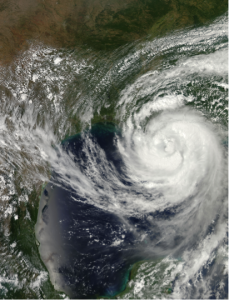On Friday, October 24, the strongest hurricane in the history of the Western hemisphere hit the coast of Mexico. The U.S. National Hurricane Center warned that “life-threatening flash floods and mudslides” were likely to occur in rural areas, but the Mexican people were well prepared to react. Hurricane Patricia made headlines as the strongest storm to hit the west coast of the Americas, climbing up to a category five storm. The Weather Channel reported the storm was unprecedented among Pacific hurricanes, dropping ten millibars lower in pressure than any previously recorded storm.
According to BBC news, the storm lessened to a category four by the time it hit the Mexican coast and the results were not as catastrophic as they might have been, helping the government of Mexico go into the natural disaster well prepared. The Los Angeles Times suggested that the president of Mexico, Enrique Peña Nieto, “benefited from what appears to have been a successful emergency response and extraordinary good luck.” Therefore, what might have ended in a major loss of human life has been nothing more than an indicator of the Mexican government’s ability to handle such natural disasters well.
 The government initiated a mass evacuation of the area that could possibly be affected by the storm. More than 10,000 people were evacuated from their homes, and 1,200 shelters were set up to house the evacuees. Ricardo Aleman of El Universal newspaper said “the hurricane put to the test the reaction of all three levels of government – and unlike many other occasions, the coordination [this time around] was almost perfect.”
The government initiated a mass evacuation of the area that could possibly be affected by the storm. More than 10,000 people were evacuated from their homes, and 1,200 shelters were set up to house the evacuees. Ricardo Aleman of El Universal newspaper said “the hurricane put to the test the reaction of all three levels of government – and unlike many other occasions, the coordination [this time around] was almost perfect.”
USA Today suggested it was not only the proper governance of the storm situation, but the natural landscape of the Mexican coast that slowed the storm and lessened damage. The area that the storm struck was a sparsely populated area, with an occasional fishing village on the coast. Immediately to the left and right of the area are the dense populated centers of Puerto Vallarta and Manzanillo, which were just missed by the storm. Dennis Feltgen, a meteorologist with the U.S. National Hurricane Center, said the storm “could have been far worse. A little jog to the left, a little jog to the right and we’d be having a different conservation.”
Another factor that affected the progress of the hurricane was its collision with the Sierra Madre mountain range. Over the course of Friday night, the mountains broke the storm apart until it dropped from a category five, to a category one by 4 a.m.
According to USA Today, the death toll, as of Sunday, had reached six citizens. Despite such a low death toll for such a massive storm, coastal Mexican infrastructure and agriculture were heavily affected. The Los Angeles Times reported as many as 3,500 homes were destroyed or damaged, and that 19,000 acres of crops were ruined by flooding and storm winds. The federal authorities are still working to assess the gravitude of the damage caused, but it is clear that in the months to come efforts must be made to restore the coastline and the livelihoods of the Mexican people.
